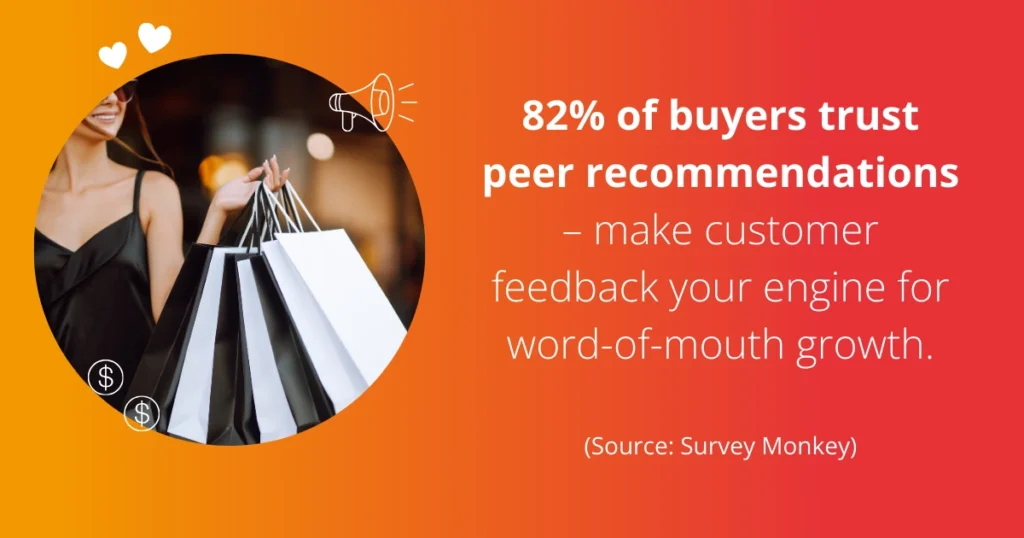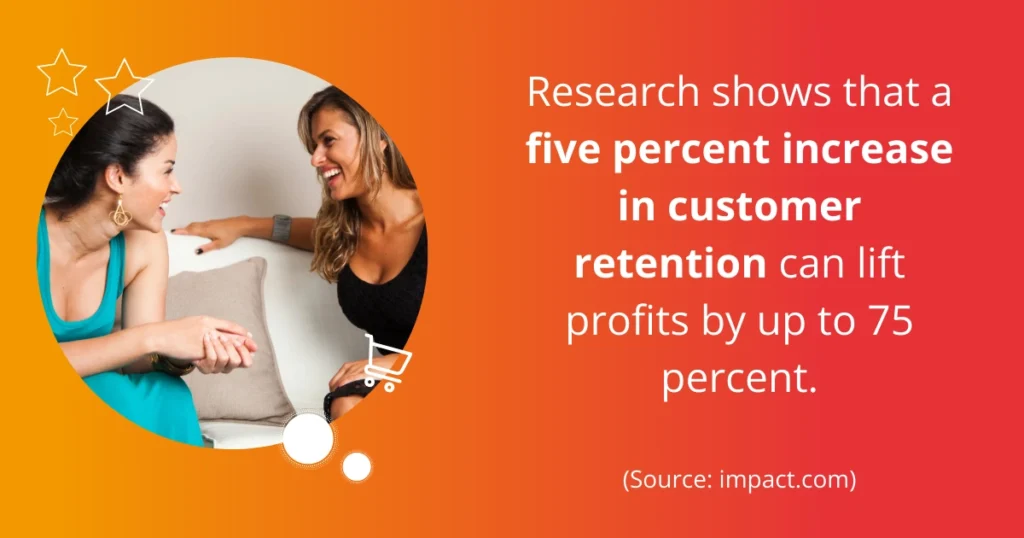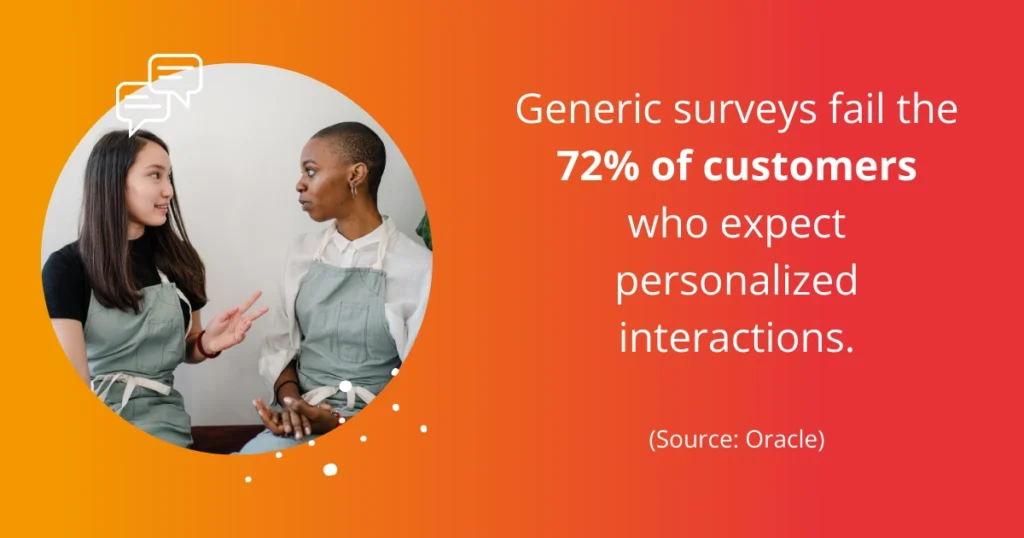Do you know what your customers really want? If you’re not collecting customer feedback, you’re guessing. Businesses that don’t capitalize on the voice of the customer are literally leaving money on the table.
Customers with positive experiences are more likely to recommend your brand to others and become repeat customers. As 82 percent of consumers trust peer recommendations over brand messages, actively sourcing customer feedback lets you mold brand perception and build loyalty to fuel more positive recommendations.
Leveraging customer feedback for product and customer experience improvement increases customer satisfaction and ripples out to:
- Stronger customer relationships
- More loyal customers
- A surge in customer acquisition
- Increased customer lifetime value
Learn the benefits of customer feedback, common challenges, and best practices for collecting, analyzing, and acting on customer insights to turn customer voices into your competitive advantage.

Benefits of customer feedback for product development
Businesses that leverage customer feedback create a domino effect of powerful benefits that fuel business growth.
Increase customer satisfaction through product innovation
Businesses that incorporate customer feedback loops into their product roadmaps are more likely to create solutions that meet or exceed customer expectations.
Satisfied customers become your unofficial R&D team. They’re more likely to share ideas in groupthink environments, which can spark conversations that lead to product innovation. Those developments can then attract new customers, expanding your market reach.
Simultaneously, involving customers in your product road mapping and innovation processes strengthens trust and rapport—building a cycle of positive engagement.
Boost customer lifetime value
Happy customers lead to higher retention and customer lifetime value. Research shows that a five percent increase in customer retention can lift profits by up to 75 percent. As acquiring new customers costs companies up to five times more than retaining existing ones, businesses benefit from investing in a retention marketing strategy.
Gathering customer feedback gives you a direct line of communication to learn how to keep them happy.

Gain a competitive advantage
When customers feel heard and valued by a business, they’re more likely to share experiences they’ve had with competitors.
These insights can sharpen your competitive edge by:
- Uncovering competitor weaknesses
- Identifying unique selling points to differentiate
- Spot market gaps
This responsive approach can help your business become customers’ preferred choice.
Improve brand perception
Nurturing trust and loyalty through a solid customer feedback loop is powerful for shaping brand perception.
Loyal customers are more likely to share positive reflections about a brand in reviews or conversations, so businesses can generate more buzz organically without increasing marketing spend.
This creates a landslide effect, as positive reviews can increase customer spending by 30%.
Common feedback loop implementation challenges
Gathering feedback sounds simple enough, but watch out for these common hurdles to ensure effective results:
- Ineffective utilization: Many businesses collect feedback but struggle with meaningful implementation, making the process pointless.
- Internal resistance: Stakeholders or employees may resist changes suggested by customer feedback, especially if it disrupts established processes.
- Data overload: Identifying actionable insights is difficult if you ask customers for too much information.
- Unclear goals and metrics: Establishing feedback methodology and prioritizing action steps is challenging without defined customer experience objectives.
- Lack of personalization: As 72 percent of customers expect businesses to recognize them as individuals and understand their interests, generic feedback approaches can deter customers from engaging with businesses.
By anticipating these challenges, you can develop a feedback loop that drives real improvements and strengthens customer relationships.

How to collect actionable customer feedback
Gathering meaningful customer insights starts with a clear purpose. Define your “why,” then consider these four effective methods for collecting feedback:
Customer feedback surveys: Customer surveys allow you to ask targeted questions about specific issues. Long surveys can lead to low response rates, so focus only on essential questions.
In-app feedback widgets: These tools capture insights without disrupting the user experience. They can prompt targeted questions or allow spontaneous feedback.
Direct outreach: Direct outreach, such as interviews or focus groups, enables deeper insights in a more comfortable setting. 72 percent of customers will talk about their experiences in person. In comparison, 50 percent won’t share them on social media—driving home the point that customers want to share in a personalized setting.
User data mapping: This method provides objective, action-based insights by analyzing how customers interact with your website or app. It uncovers unconscious patterns in user behavior that customers might not answer questions about.
Consider combining approaches for a comprehensive view of your customer experience, depending on your goals.
Best practices for analyzing and interpreting customer feedback
Customer feedback can unlock many insights—if you know how to extract them. Turn raw customer feedback data into actionable insights with these best practices:
- Leverage technology: Many survey tools and feedback widgets can automatically organize and visualize your data, saving time and providing quick insights.
- Balance quantitative and qualitative data: Combine numbers and customer comments to get a complete picture of your customer experience.
- Categorize feedback: Group similar comments or issues to identify patterns.
- Embrace automation: Consider using automated customer feedback tools to streamline collection and analysis processes. Modern tools can identify patterns in large amounts of subjective data.
- Define prioritization factors: Create a scoring system that weighs impact factors (customer satisfaction and revenue potential) and effort factors (development needs and resource requirements).
- Consider urgency and impact: Consider the prioritization factors you defined to evaluate each piece of feedback’s significance and how quickly it needs to be addressed.
- Conduct root cause analysis: Use “5 Whys” techniques to identify underlying issues and develop more effective, lasting solutions.
- Look for trends over time: Track how sentiments and issues evolve to spot long-term patterns and gauge the impact of your improvements.
This approach can uncover insights that drive meaningful product and customer experience improvements.
Close the feedback loop
Close the customer feedback loop after your team has collected the data to build lasting relationships.
Thank your customers to show you value their time and thoughts. Briefly communicate your plans to act on their feedback to build trust and manage expectations.

Keep customers updated on your progress to reinforce the value of their input and encourage future participation. A reported 70 percent of customers will do business again with a company if a complaint is resolved in their favor, so this is an essential step in increasing customer satisfaction and fostering loyalty.
When done right, implementing a robust customer feedback system transforms customers into partners in your growth—driving innovation, loyalty, and business success. So, start listening and watch your business thrive.




